Integration in money laundering: how it works and how to detect it
- azakaw

- Sep 24
- 8 min read
Updated: 19 hours ago
Integration in money laundering is the final step where illicit funds, after being placed and layered, are reintroduced into the economy disguised as legitimate income.
Understanding the meaning of integration in money laundering is crucial because this is the stage at which criminals succeed in blending “cleaned” money with legitimate financial flows.
In this article, we examine how integration works, its significance, and the risks it poses to businesses and regulators worldwide.
Key Takeaways: Integration in Money Laundering |
|
|
|
|
What is integration in money laundering?
Integration is the final stage of the money laundering process, where illegally obtained funds are reintroduced into the legitimate economy, appearing as legitimate income or assets.
After the placement and layering stages have masked the origin of the illicit funds, integration provides them with a false sense of legitimacy, allowing criminals to use them without suspicion.
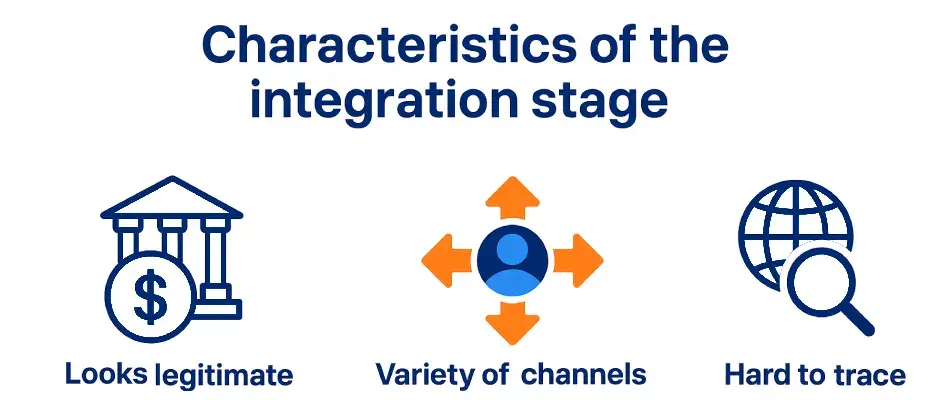
Key characteristics of the integration stage
Looks legitimate: the illicit funds are often mixed with genuine income or invested in legitimate businesses, making them more difficult to detect.
Variety of channels: criminals may use property transactions, investments in securities, or trade-related activities to obscure the source of the money.
Hard to trace: once integrated, tracking the criminal origins of the money becomes extremely challenging.
Why integration is critical for money launderers
Without successful integration, criminals cannot fully profit from their illegal activities.
It is this stage that transforms "dirty money" into spendable, seemingly actual, genuine wealth, allowing them to continue financing criminal enterprises, invest in or acquire lawful businesses, and influence political systems, local communities, and even entire markets.
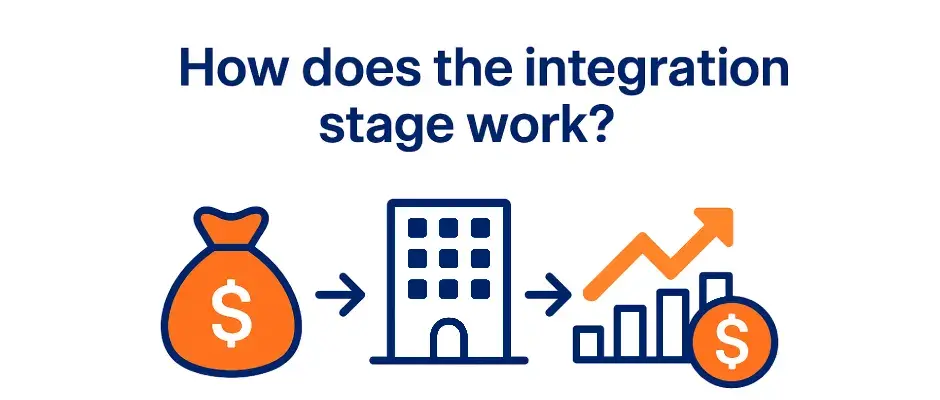
How does the integration stage work?
Once illicit funds are ready to be reintroduced into the economy, criminals turn to sophisticated methods to conceal their true origins.
Integration isn’t usually a one-off event; it’s a series of calculated steps, each designed to build the appearance of a legitimate financial history.
In this section, we’ll explore the most commonly used techniques, as well as the warning signs that compliance teams need to be alert to.
What are the methods of integration in money laundering?
The common strategies to integrate money in the financial system include: buying and selling real estate, setting up shell companies or trusts, investing in businesses using fake revenue or loans, acquiring luxury assets, transferring money through offshore accounts, and engaging in trade-based money laundering by mispricing or falsifying invoices.
Purchasing property: real estate is used quite often due to its high value and relative market stability. Criminals might overpay, underpay, or repeatedly buy and sell properties (known as "flipping") to obscure the origins of their funds.
Shell companies and trusts: these opaque corporate structures help hide the true identity of those controlling the money, making it harder to trace.
Investing in legitimate businesses: illicit funds can be introduced as business loans, capital injections, fake revenue, etc., making them seem lawful profit.
Buying luxury items: assets such as high-end jewellery, artwork, yachts, and luxury vehicles serve as portable and valuable stores of wealth*, often bought in cash or via intermediaries.
Using offshore accounts and tax havens: Funds are routed through jurisdictions with limited financial transparency and lax regulatory oversight, making detection more difficult.
Trade-Based Money Laundering (TBML): This involves manipulating trade documents, mispricing goods, or falsifying invoices and shipping details to disguise illicit financial flows.
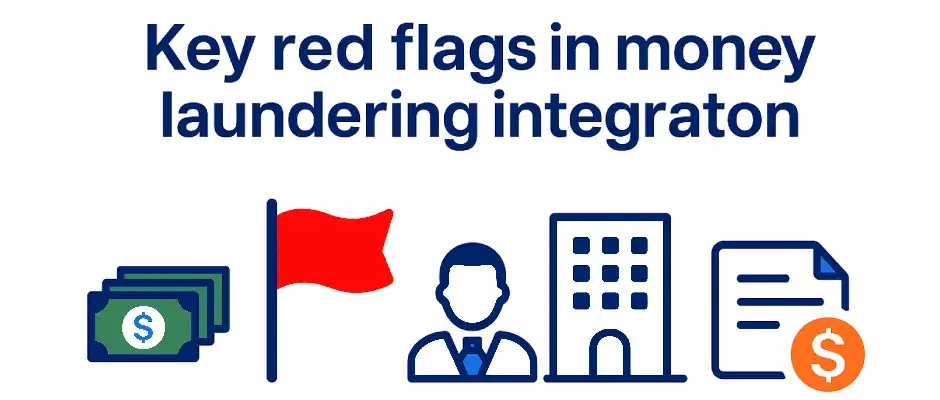
Key red flags in money laundering integration
To identify the integration of illicit funds, financial institutions and regulators closely track suspicious behaviour and recurring patterns.
Drawing on years of case experience and industry knowledge, these red flags are used to separate routine financial activity from transactions that may indicate money laundering.
Unexplained wealth: a client purchasing multi-million-pound properties with no clear or legal source of income.
Complex ownership structures: the use of layered shell companies or trusts in high-risk countries to hide beneficial ownership.
Unusual trade activity: transactions involving invoices that are priced very much above or below market value, which may indicate deliberate manipulation.
Third-party involvement: assets or funds held or purchased in the name of relatives, associates, or nominees, masking the true beneficiary.
A mismatch between lifestyle and declared income, for example, someone with modest earnings who suddenly buys a luxury property or expensive artwork.
Funds being converted into physical assets such as real estate, prepaid cards, and even high-end goods, sometimes after passing through digital currencies like crypto.
Businesses whose financial activity looks far bigger than what their declared operations or industry size would normally suggest.
The use of tax havens or lightly regulated jurisdictions, including freeports, where valuable items can be stored with a high level of anonymity and favorable tax treatment.
Recommended article: What is beneficial ownership?
Challenges in detecting integration activities
When the money has passed through the placement and layering phases, it often looks entirely legal, and the usual red flags become much harder to spot.
This section examines the key challenges faced by financial institutions and regulators as they work to identify and prevent integration from taking place.
Read also: How to prevent money laundering
Real-world cases from the financial sector
Property markets in cities like London, New York, and Vancouver have become hotspots for suspicious financial activity, with billions in questionable funds moving through anonymous shell companies.
Several major banks have faced substantial fines for failing to detect or report transactions linked to high-risk individuals, revealing serious gaps in their anti-money laundering (AML) systems.
Common barriers faced by law enforcement
Lack of transparency across borders: criminals often take advantage of offshore financial centres where secrecy laws and weak oversight make it extremely difficult to trace money trails.
Limited resources: many enforcement agencies struggle with underfunding, understaffing, and outdated technology, all of which hamper efforts to uncover and investigate sophisticated laundering operations.
The growing complexity of criminal tactics
Modern money launderers are becoming increasingly tech-savvy.
They now use tools such as cryptocurrency mixers, AI-powered algorithms, and manipulative trade practices to hide the origin of illicit funds.
These methods are faster, more dynamic, and significantly harder to detect than traditional laundering techniques.
The role of globalisation
In today’s interconnected world, money can move across borders within seconds.
This fluidity makes it challenging for regulators and enforcement bodies to monitor suspicious financial flows, particularly in the absence of strong international cooperation.
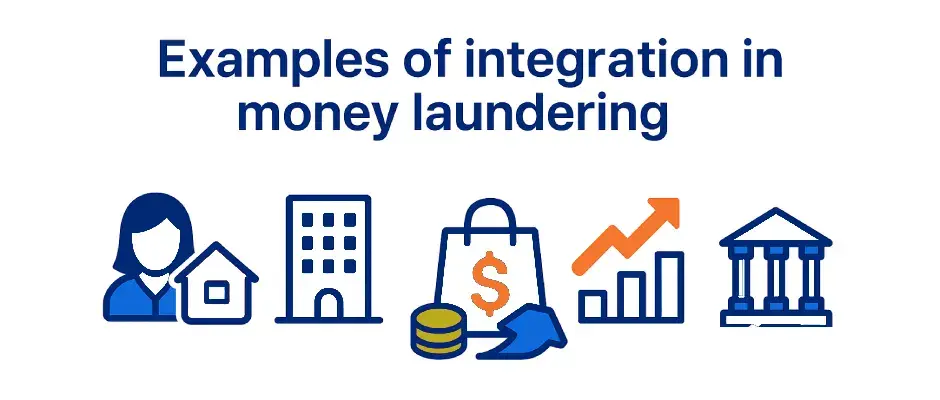
Examples of integration in money laundering
While theories help explain how illicit funds are reintroduced into the economy, real-world cases expose the scale and sophistication of integration schemes.
From banks processing shell company transactions to scandals involving luxury assets, these examples show how criminals exploit loopholes and why regulators and institutions must remain vigilant in enforcing anti-money laundering (AML) measures.
Danske Bank (Estonia): shell companies used to reintroduce funds (2007 - 2015)
The Danske Bank scandal is one of Europe’s largest money laundering cases.
Billions of dollars were channelled through the bank’s Estonian branch using non-resident shell companies. These entities were structured to obscure beneficial ownership, allowing illicit funds to appear legitimate as they flowed into Western financial systems.
The case revealed serious compliance breaches and led to heavy regulatory penalties for the bank.
1MDB: luxury art and high-value assets to integrate illicit proceeds (2012 - 2016)
The 1MDB scandal in Malaysia highlighted how luxury goods can be used at the integration stage.
Money siphoned from the state development fund was spent on diamond jewellery, rare artworks by Picasso and Basquiat, and even a superyacht. Such purchases converted dirty money into assets that could later be resold, making the funds appear clean.
This case has become one of the most notorious money laundering scandals in modern history.
Azerbaijani Laundromat: sham loans and corporate investments via UK LLPs (2012 - 2014)
The Azerbaijani Laundromat involved billions moving through UK-registered shell companies and European banks. The money was disguised as loans, investments, and consulting fees.
This is a money laundering scheme that enabled elites to fund extremely expensive lifestyles while exposing serious weaknesses in corporate transparency laws. It remains a textbook example of how false loans and layered ownership structures can support integration.
Black Market Peso Exchange (BMPE): trade-based laundering via peso brokers (1990s - present)
The Black Market Peso Exchange (BMPE) illustrates how trade can be manipulated to achieve integration.
Latin American drug cartels sold U.S. dollars to peso brokers, who used false trade invoices and manipulated pricing of goods to convert illicit funds into local currency.
Once laundered through international trade channels, the money was absorbed into the formal economy. This method has proven to be one of the most enduring and effective forms of trade-based money laundering.
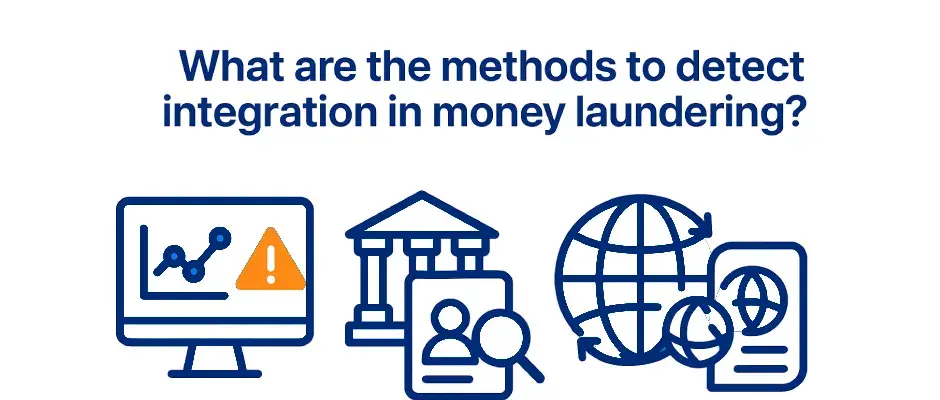
What are the methods to detect integration in money laundering?
Given the complexity and sophistication of integration schemes, regulators and financial institutions must rely on a mix of technology, intelligence sharing, and international collaboration to tackle the threat.
This section explores the key tools and frameworks used to detect and disrupt the integration of illicit funds into the legitimate economy.
Transaction monitoring systems
Banks and financial institutions use AML technologies that include advanced transaction monitoring systems, algorithms, artificial intelligence, and behavioural analytics, to detect suspicious activity in real-time.
Financial Intelligence Units (FIUs)
FIUs play a key role by reviewing Suspicious Activity Reports (SARs) and Suspicious Transaction Reports (STRs). They provide law enforcement with critical intelligence to investigate and prosecute money laundering cases.
Customer Due Diligence (CDD) and Know Your Customer (KYC)
CDD and KYC processes help institutions verify customer identities and identify beneficial ownership, high-risk clients, and unusual behaviour.
For individuals such as Politically Exposed Persons (PEPs) or sectors like real estate, Enhanced Due Diligence (EDD) is usually applied.
Related article: AML obligations for real estate
International cooperation and FATF guidance
The Financial Action Task Force (FATF) sets international AML standards and encourages global collaboration.
Countries are urged to share information, strengthen laws, and address weaknesses that criminals exploit to move money across borders.

The impact of integration on the economy and society
Distorting financial markets
When large volumes of illicit money flow into sectors like property, asset prices can rise, which makes essentials such as housing unaffordable for everyday citizens.
Fueling corruption and organised crime
Once integrated, laundered funds are often used to support criminal enterprises, terrorism, and corrupt networks, reinforcing cycles of harm and instability.
Risks to financial institutions
Banks and businesses that fail to detect money laundering may face strong penalties, regulatory sanctions, and lasting reputational damage.
Erosion of compliance and public trust
When integration goes unnoticed, it undermines trust in the financial system. This can lead to public backlash and increased pressure on governments to impose stricter regulatory measures.

FAQs
Is money laundering a federal crime?
Yes, it is. In countries like the United States, money laundering is classified as a federal offence, carrying serious penalties, including substantial fines and lengthy prison sentences.
What is smurfing?
Smurfing is a money laundering tactic where large sums of illegal cash are split into smaller deposits to avoid detection during the placement stage. It’s designed to fly under the radar of reporting thresholds.
What are the three stages of money laundering?
The three stages of money laundering are placement, layering, and integration.
What is an example of integration in money laundering?
A typical example would be a criminal using illicit funds to buy luxury property, then later selling it to generate income that appears entirely legitimate.
What does the term "anti-money laundering" mean?
Anti-Money Laundering (AML) refers to the set of laws, regulations, and procedures that aim to prevent criminals from disguising illegally obtained funds as legitimate income.
What is AML in simple terms?
Put simply, AML is the global effort to stop criminals from making “dirty money” look clean.
Conclusion
The meaning of integration in money laundering is beyond being the final stage; it’s where illicit funds are absorbed into the legitimate economy, often through real estate investments, shell companies, luxury assets, or trade manipulation, allowing criminals to enjoy their wealth without raising suspicion.
For financial institutions, regulators, and governments, detecting and preventing integration remains a major challenge. Addressing it effectively requires:
Strong and proactive compliance programmes,
Advanced monitoring and detection systems,
International cooperation between agencies and jurisdictions,
Greater transparency around who truly owns companies and assets.
Ultimately, tackling integration isn’t just about protecting banks from financial crime. It’s about safeguarding the integrity of the global financial system, ensuring fair and transparent markets, and limiting the influence of criminal networks on society as a whole.
Related articles






